The future of laser tag - prosperity or Digital Darwinism?
by Randy White, CEO, White Hutchinson Leisure & Learning Group
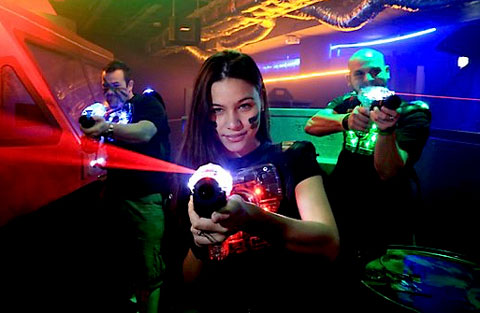
For location-based entertainment and FEC venues, digital technology can be a double-edged sword. Technological advancements in management tools and attraction technology can improve operating efficiencies and enhance the guest experience. At the same time, advancements in digital technologies for at-home and mobile screen entertainment become new and compelling competition to bricks-and-mortar entertainment.
Nowhere is this truer than with indoor laser tag centers. Advancements in technology have greatly enhanced game equipment, the game experience and operations. Even such simple advancements as LED lights have enhanced the arena atmosphere and play and lowered operating costs. Now we even have projection mapping that “paints” the laser tag arena's walls, which not only can change the theme of the arena at a touch of the button, but the images can also interact with the shooter (to see a short demonstration video by Arc Laser Tag Arenas, click here).
We've seen rapid growth in the indoor laser tag industry despite the Great Recession. It's grown from 581 facilities in 2008 to 979 at the end of 2014. That's a 9% annual compound growth rate.
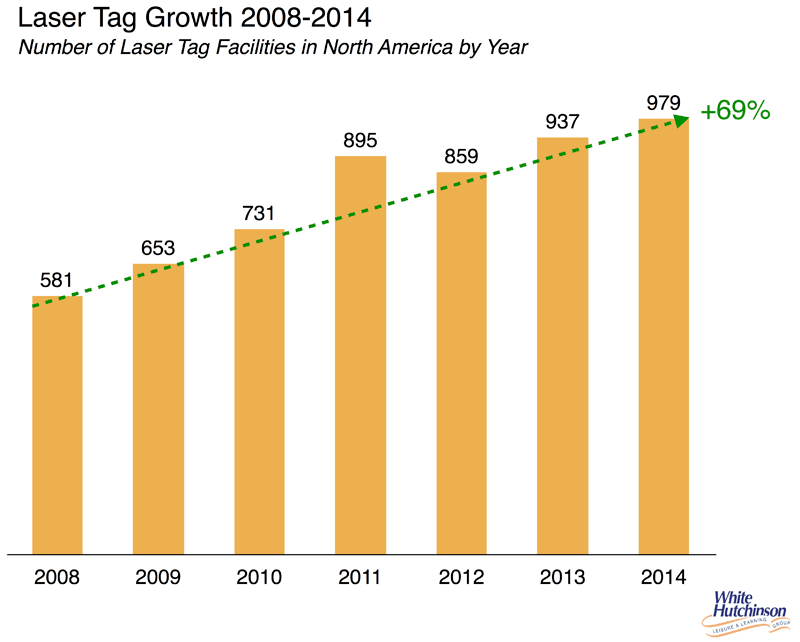
On the at-home and mobile screen-side of the entertainment landscape, some digital advancements have actually increased the popularity of laser tag. Laser tag is the real world equivalent of first-person shooter multiplayer video games. 59% of Americans play video games. 40% of Americans play on a game console and 37% play on computers. 51% of households own a dedicated game console with an average of two consoles per household.
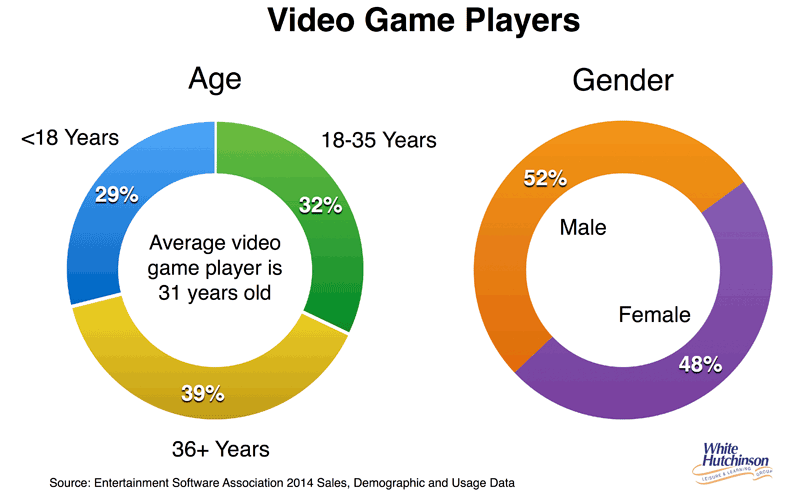
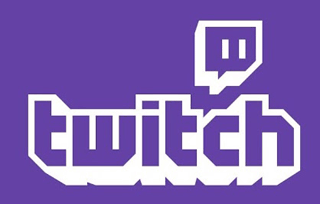
A new phenomenon, eSports, that is watched live in arenas or viewed on Internet channels such as Twitch.tv is adding to the popularity of multiplayer video games.
The broad popularity of video games has attracted many players to also enjoy laser tag.
Of course, at the same time, the increasing high quality of today's first-person shooter multiplayer, including massively multiplayer, video games has raised the bar for getting people away from their screens and out of their homes.
So we currently have two game worlds. You watch a screen and manipulate figures on the screen or you are physically be in a real world laser tag arena as the shooter.
So what does the future hold for laser tag? Will the growth continue or is there a disruption on the horizon?
That disruption could very well be the next advancement for video games; an alternate 3-D pixelated reality called virtual reality (VR) or augmented reality (AR). We already have headsets like Oculus VR or Samsung Gear VR. But while headsets or goggles offer an immersive experience, the quality is not yet up to a realistic experience in image sharpness. The current screen change rate also causes some people to experiences symptoms similar to motion sickness known as cybersickness. This has to do with the inability of game controllers and personal computers to render images in real-time fast enough and in high enough definition. At the speed that computing power is growing in devices, that barrier is sure to be overcome in the very near future.
In addition to Facebook owned Oculus Rift and Samsung's Gear, we also have the half+ billion dollar funded Magic Leap with Google as a major backer, Sony with its Project Morpheus and Microsoft's HoloLens (name inspired of course by the Star Trek Holodeck) for its Xbox One gaming system.
Both Google and Microsoft are taking a different approach than the Oculus and Gear VR headsets, which are in effect a screen you view giving you an VR immersive experience while you are blind to the outside world. Rather, Google and Microsoft are using blended reality by overlaying projected holograms of virtual objects that populate and you see in a form of AR in the real physical space you occupy. To better understand the use of this quasi-VR approach, check out this 1.5-minute video showing how Magic Leap uses blended reality to turn an office into a first-person shooter battleground.
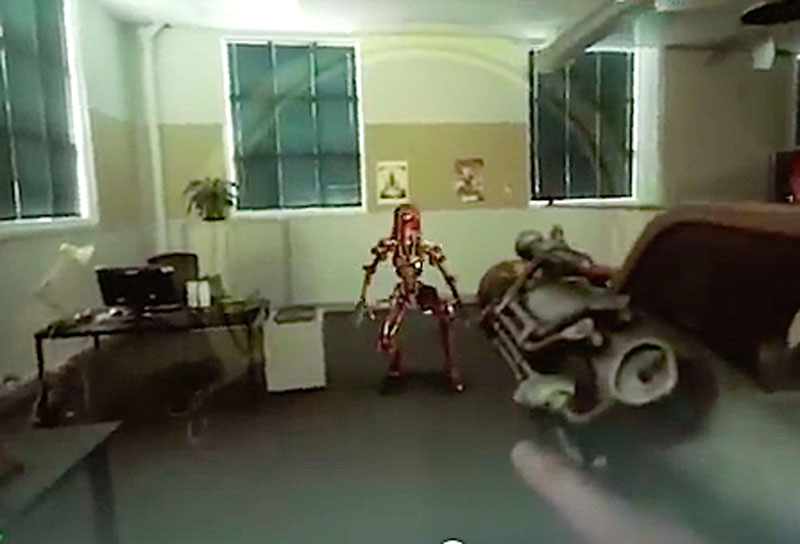
Scene from HoloLens first-person shooter VR game (click to play)
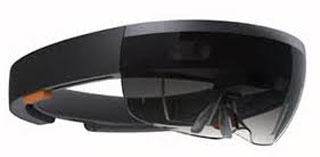
HoloLens untethered headset
So instead of just watching a screen, you are actually in the middle of the game occupying real 3-D physical space. And the headset is untethered, allowing you to move around the transformed space. In fact you can even move about holographic objects. Not quite the Star Trek Holodeck, but it is sure getting close.
Oh, and just to blow your mind a little more about what is on the horizon in the world of VR, the Swiss company MindMaze has announced VR that you control with your mind with its MindLeap neurogoggles that can be played on such devices and platforms as Xbox, PlayStation, iOS and Android. MindMaze CEO Dr. Tej Tadi says that MindLeap's “combination of neuroscience, virtual reality, augmented reality and 3D full-body motion-capture will allow gamers to see, feel and experience virtual gameplay with absolutely no delay or need for controllers” and put their minds in the game in new ways.
“VR now is poised not only to challenge reality's stranglehold on the way we engage with life [and entertainment], but possibly even eclipse it for sheer thrills.”
USA Today
So let's jump forward a few short years (not all that many at the rate technology is advancing) to when you are no longer shooting holographic robots like in the video, but immersed in a multiplayer AR experience where rather than robots, the enemy is real-life looking projections of your friends and you are moving around projected barriers, just like in a laser tag arena. And the virtual arena's layout and design can be instantly changed for a never-ending variety of game experiences. And with a fast Internet connection, your friends can be located anywhere in the world (we're already up to 1.0 gigabit Internet speeds in some locales). That will be the killer AR app and likely to catapult digital reality technology into instant ubiquity in the gaming world.
Now that sure isn't much different than a game in a real laser tag arena. So why go to the laser tag arena when you can just stay home and have a very similar experience without all the hassle, energy and time to travel to some venue? This will definitely be a game changer for laser tag venues.
This is really scary stuff for laser tag facilities and developers. Will virtual reality and augmented reality become their digital Darwinism? There are two possibilities. But first let's look at where laser tag could go without this disruption.
Over the past six months our company has conducted national surveys of over 12,000 households on participation in different family entertainment center type attractions, including indoor laser tag. Based on participation rates we found in those surveys, projected increases in participation rates as facilities become available in areas lacking convenient laser tag arenas, projected population increases and the needed attendance to economically support a facility, we have projected the number of indoor laser tag facilities that could be supported into the next ten years. We estimate there is the potential for 1,480 indoor laser tag venues, a 50% increase over the current number.
However, that projection does not factor in the disruption that home-based VR and AR could cause, no different than what happened with the decline of video game arcades as console- and PC-based video games grew in popularity and sophistication. There is a real possibility that within ten years the sophistication and popularity of at-home first-person shooter multiplayer virtual reality games could result in less laser tag facilities being supportable than today.
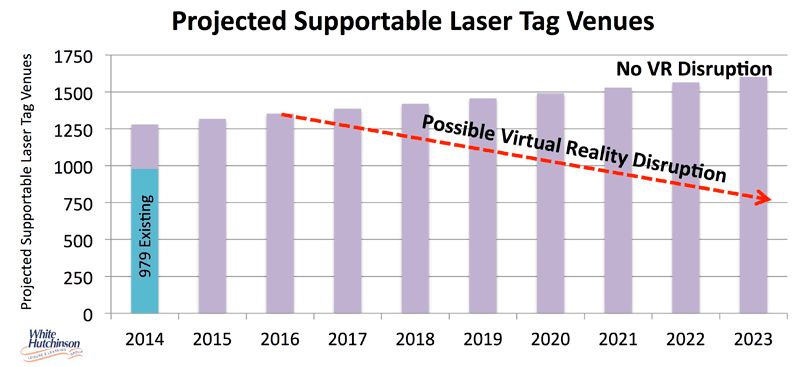
The truth is, whether laser tag operations want to admit it or not, at-home VR and AR games are becoming and will increase to be a new competitive threat.
The possibly disruption of laser tag by VR brings up a discussion of the bifurcation of entertainment experiences into either High Fidelity or Convenient ones. A High Fidelity experience is a high quality, premium and more expensive experience, whereas a Convenient one is low cost and readily available. A well done laser tag arena is a High Fidelity experience whereas an at-home VR gaming experience is Convenient - extremely inexpensive to play and highly convenient.
To succeed, you either have to be at one extreme or the other of the Fidelity-Convenience continuum. Being in the middle means the experience falls in the Fidelity Belly and has no or little appeal. Music on CDs, which at one time was state-of-art Convenient, fell into the Fidelity Belly when mp3 music become more Convenient. At the other end of the continuum, live music concerts had to increase their Fidelity with advanced tech and more pyrotechnics to stay competitive.
The more Convenient experiences become, the higher the Fidelity, the alternative at the other end of the continuum, has to become to stay attractive. And paradoxically, people are willing to pay a higher price for that High Fidelity experience, as it has a higher perceived value.
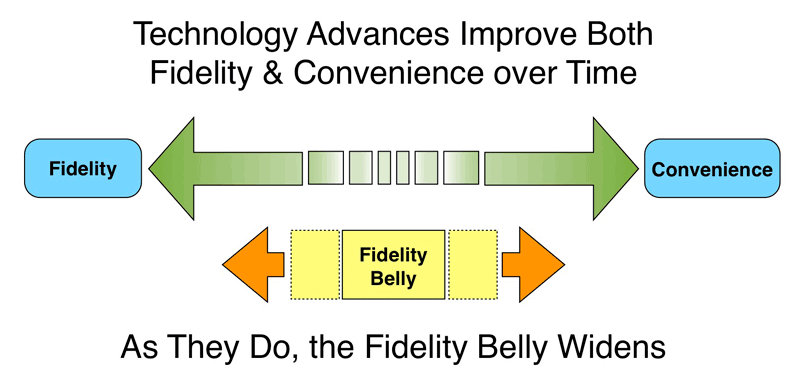
As both Fidelity and Convenience improve over time, what at one time was a High Fidelity experience finds itself in the Fidelity Belly with little or no appeal.
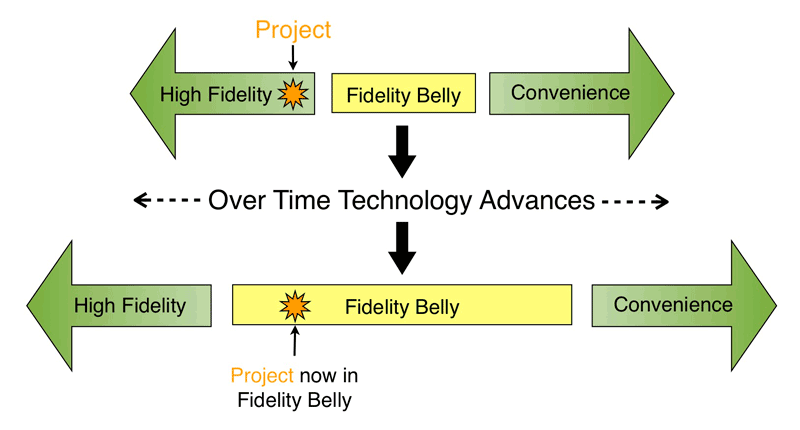
What is happening today is that technology is advancing at a faster pace than ever, so what were once High Fidelity experiences are finding themselves in the Fidelity Belly much sooner than in the past.
This is exactly what can happen to indoor laser tag with the introduction of VR and AR into home gaming. If laser tag doesn't raise its Fidelity, it can easily find itself in the Fidelity Belly and lose its appeal, no different than what happened to video games in arcades.
But wait a minute; we still have very successful game rooms, although not freestanding like the heavily video-based arcades of years ago. What happened is game rooms reinvented themselves with redemption games and relocated into multi-attraction venues, as they lost their appeal as a stand-alone attraction.
The bottom line for laser tag is that at-home VR and AR, as well as other forms of screen-based digital entertainment, will continue to advance in their sophistication and highly affordable costs - their Convenience.
Our company has documented a long-term trend that started around the turn of the 21st Century of at-home and mobile digital entertainment taking market share of both leisure time and spending away from all forms of bricks-and-mortar entertainment.
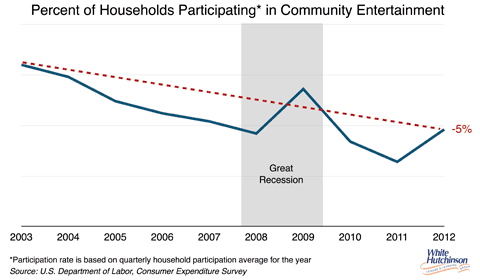
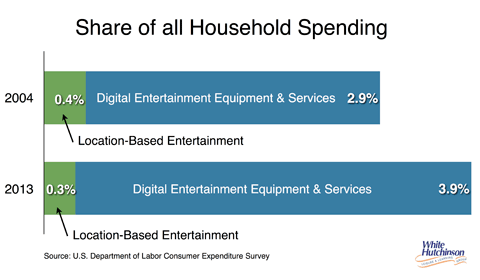
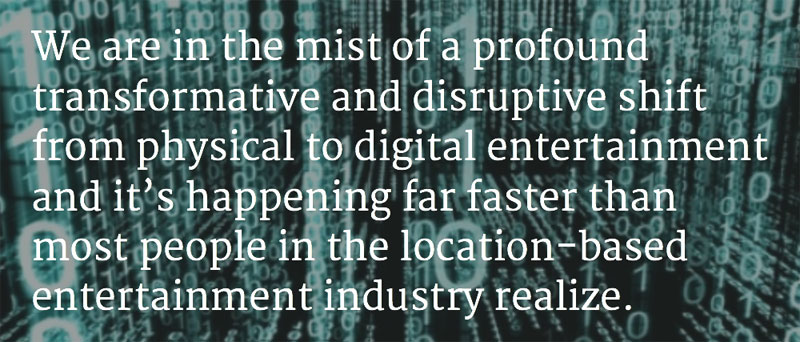
And more so than other forms of FEC-type attractions, laser tag faces a similar replacement challenge from VR and AR that movie theaters have faced with at-home and screen-based films, now even more Convenient than ever with HD and growing Ultra HD televisions and instant streaming. Over time as the at-home movie experience has improved in Convenience, cinemas have had to raise their Fidelity to compete.
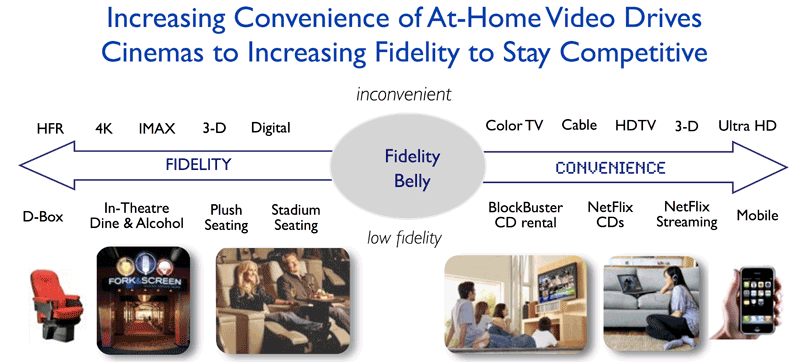
Still, with all the improvements movie theaters have made to the moviegoing experience, North American cinemas have lost one-quarter (27%) of their per capita attendance since the turn of the century. Whereas at its peak in 2002 when North Americans attended the movies on average 4.9 times that year, last year it had declined to 3.6 times.
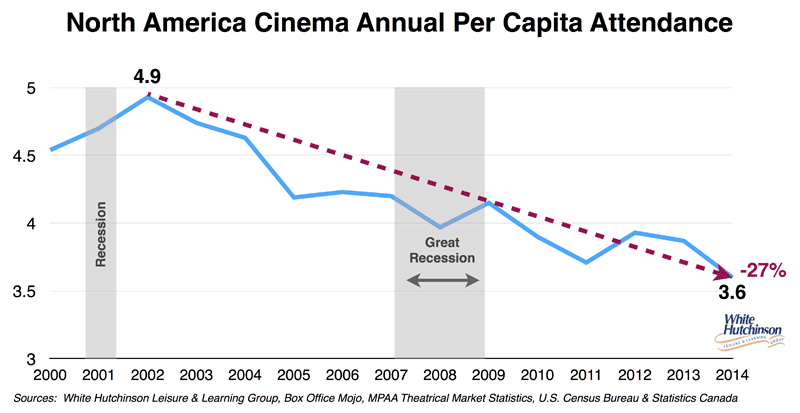
To succeed into the future, indoor laser tag needs to reinvent itself much as game rooms have, to raise the Fidelity of both the game play and the overall visit experience.
This requires taking a holistic view of what visiting a laser tag venue is all about. So many laser tag operators think it's only about the entertainment of the game play. However, it's a whole lot more than just the fun of playing laser tag. First and foremost it's a group social experience. The group socialization in most cases is a far greater motivator for the visit than the game play. The game play is a facilitator of socialization. We are biologically hard-wired by evolution to socialize. We are not hard-wired to play laser tag. The social dynamic of the visit is critical to the appeal of attending. So improving the Fidelity of the socialization is key to improving laser tag's appeal.
A large part of the socialization is the debriefing by the group after they have finished playing. This is where so many facilities miss the boat. They don't have a great socialization space, so players just leave immediately after playing to go to a restaurant or bar. To truly socialize, people need to be playing something together, holding a drink in their hands or be eating something. After the play, that requires food and beverages, and not just some junk snacks and non-alcoholic beverages. Today in our foodie nation, that requires at a minimum a selection of savory small plates and beer and wine service. In fact, if you want to attract the adult market, you need alcoholic offerings. Good F&B, including alcohol, is essential to attract adult and corporate groups.
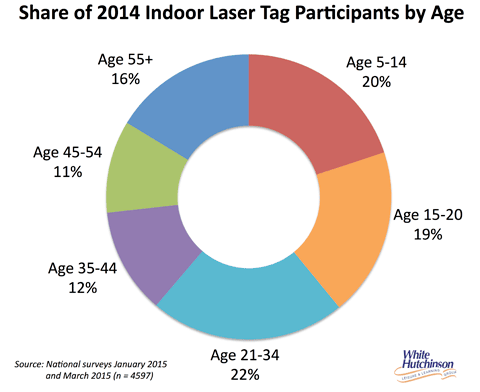
If you have any doubts about attracting adults, they are the largest laser tag market, making up the majority (62%) of all players based on our company's national surveys (Yes, the long-promoted belief that “The primary demographic for laser tag is between 6 and 14 years of age” is nothing but an industry myth).
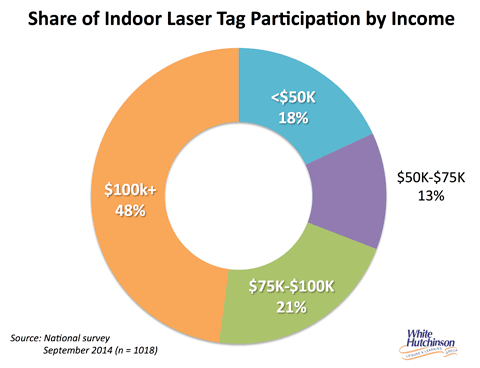
There is also a belief that laser tag venues should target the middle class. That might have been the case a decade or so ago. However, for multiple reasons, we have lost the middle class as the primary target market. Our company's research shows that today, half (48%) of laser tag players come from affluent, $100,000+ income households, which are only 19% of all households.
And just like video game players, a growing proportion, more than one-third (38%), of laser tag players are female.
If you want to attract upscale adults, you need to design for them rather than design for children. That requires a reasonably upscale interior finish rather than just a warehouse finish. If you design for upscale adults, you will still get the families coming with their children. There's not a kid in the world 6 or older who won't rather visit a adult-oriented entertainment center than a kid one.
Laser tag facilities that lack a great upscale socialization space offering good contemporary food and drink miss out on a lot of additional revenue from the F&B as well as repeat business. It also limits their market reach. There is a direct relationship between length-of-stay and travel time to get to an entertainment venue. If the length-of-stay is longer when players stay around and socialize after they play, as well as come earlier to socialize before playing, the market area will be larger.
Socialization around food and drink is the one thing you can't do playing video games on the Internet, even with virtual reality. A great socialization environment with great food and drink raises the Fidelity of visiting a laser tag venue.
Just as single attraction arcades have almost entirely disappeared, single attraction laser tag venues may also be going down the road to extinction. Single attraction bowling alleys are already suffering that fate. The entertainment centers that are attracting consumers most successfully today are multi-anchored and upscale, targeting a socioeconomic higher than just middle class. At a minimum they have destination F&B, which is an anchor attraction itself if done well. In fact the F&B can become the strongest anchor to drive repeat attendance. Many facilities also include a substantial game room, a la, Dave & Buster's. Many have three or more entertainment attractions, such as bowling, laser tag and a game room. Major players such as Main Event have even more.
As laser tag turns thirty, digital technology advancements are putting it at a major turning point. Those venues that only consider other laser tag facilities as their competition are sure to suffer extinction from Digital Darwinism with coming advancements in at-home entertainment. Those that understand how mobile, and especially at-home digital entertainment with its coming advancements in virtual and augmented reality are their new competition have the opportunity to reinvent the indoor laser tag visit experience to prosper into the future.
Remember the wise advise from Yogi Berra, “The future ain't what it used to be.”


